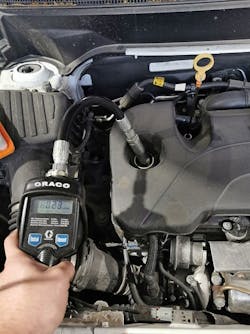We were about to go on a camping trip in our pickup truck and 27-foot travel trailer. We pulled into the gas station to get fuel, and one thing I noticed after the gasoline price — 2.22 Canadian dollars per liter (or $10.92 per gallon) — was the fact there was not one hood up or open.
Now, that may not come as a surprise to many readers but if you have read any of today’s vehicle owner’s manuals or watched the owner’s manual DVD you might come across this small information tidbit that says the following:
2017 Chevrolet Silverado: At each fuel stop: check the engine oil level.
2019 Honda CRV: We recommend that you check the engine oil level every time you refuel.
2019 Ford Escape: Check every month, engine oil level.
2021 Ram 1500: Check the oil level at regular intervals, such as every fuel stop.
The owner’s manual on these and many other vehicles is very specific on the fact that the manufacturer wants the level of the engine oil checked often to ensure that the correct engine oil level is maintained.
But, even after reading this, when was the last time you saw a hood up and someone checking the oil on their vehicle?
Today’s drivers are not conditioned the same way their grandparents or great-grandparents were to look at the engine oil level. Some of today’s engines don’t have dipsticks but there is a dash reading and procedure to verify the proper level.
The common theme now is that the dash will tell me when the oil needs to be changed or topped up.
So if the driver or owner of a vehicle isn’t going to check the actual engine oil level, even infrequently, they are not likely going to be that concerned about the correct engine oil being installed if and when the dashboard tells them they need an oil change.
While the installation of the correct engine oil may not be an important item to a customer when they arrive at our shop for service, the type of oil that is installed in the engine is beyond important.
As technicians it is our job to ensure that the correct engine oil is installed that will meet or exceed what the manufacturer expects.
But why is the use of the proper engine oil so important? There are many reasons, and it is a constantly changing field that technicians need to pay close attention to. The proper engine oil will ensure that the engine in the vehicle will perform as designed and produce the power, fuel economy, low emissions, durability and engine longevity that today’s customers demand. The engine oil must prevent engine component wear, limit timing chain wear, and prevent sludge, varnish and oil deposits. It must control deposits in the turbocharger, on the engine’s pistons (top and bottom) and prevent low-speed pre-ignition (LSPI). LSPI or super knock, as it is often called, is a potentially catastrophic engine problem that occurs when tiny particles of fuel and oil self-ignite in the combustion chamber. Turbocharged gasoline direct-injection engines are prone to LSPI. Rods, pistons, piston rings, cylinder walls and spark plugs can all be damaged by severe LSPI conditions. Today’s engine oils must limit oil evaporation or volatility that can result in low engine oil levels. Extended oil change intervals and the use of low viscosity engine oils can result in increased oil volatility.
The manufacturer’s recommended engine oil will have the needed oil additives to prevent LSPI, limit oil volatility, wear, deposits, sludge and foaming, and still supply the cleaning and lubricating protection that is required.
Before we just install new engine oil into an engine, there are several crucial details that we need to pay particular attention to. We need to know what engine oil the manufacturer wants installed.
But where do we find this data? The owner’s manual is the best source of this information, but most of our up-to-date information service systems provide this as well.
The manufacturer is going to be specific on the type of oil (conventional, semi-synthetic or full synthetic), the oil grade (SJ-SP, GF-6A, GF6B), any particular specifications and finally the engine oil viscosity. All these pieces of information must be known before we install new oil into a vehicle’s engine.
Once we have found out what the manufacturer wants for engine oil, we need to examine the oil bottle/container or bulk oil information package and ensure the oil we are going to install is correct and meets the needed specifications. The information about the oil we are installing must provide the oil’s type, viscosity, OEM performance specifications and display one or a combination of the following symbols.
The Symbols
The American Petroleum Institute (API) Service Symbol Donut. The API provides a license to apply the donut symbol so consumers know the engine oil they’re buying meets API’s engine oil standards.
The API Starburst. The API Starburst is another symbol to look for on the package or specification sheet of the engine oil you are installing. This symbol signifies the oil meets the most up-to-date specification provided by the International Lubricant Specification Advisory Committee and the engine oil will meet the additional fuel economy and emission system protection requirements. As of May 1, 2021, all oil products displaying the Starburst must meet the API SP/Resource conserving specs.
International Lubricant Specification Advisory Committee (ILSAC) Shield. The Starburst certification will remain on legacy products (0W-20, 5W-20, 0W-30, 5W-30, 10W-30), but the Shield is the new identification mark for the ILSAC SAE 0W-16 viscosity engine oil. ILSAC GF-6 oil specifications are now broken into two separate standards, ILSAC GF-6A for legacy viscosity grades and ILSAC GF-6B for SAE 0W-16. ILSAC GF-6A and its legacy grades will be backwards compatible, but the ILSAC GF-6A is not.
Oil type
There are three common types of engine oil used today. Conventional engine oil is a base mineral oil, derived from crude oil-based products. Synthetic engine oil is a manufactured chemical compound that is engineered to provide enhanced lubrication properties and supply significant benefits. Synthetic engine oils provide superior low temperature performance, higher thermal stability, lower volatility, better shear performance and other enhancements over conventional engine oils. Semi-synthetic engine oil is a combination of conventional oil and synthetic oil. There is no classification as to how much synthetic oil is blended with conventional engine oil to create a semi-synthetic engine oil blend.
Viscosity
This is the most common engine oil term that seems to get a tech’s attention when talking about engine oil. The viscosity number is a value that just seems to jump out when we talk about engine oil. The trouble is that many techs don’t understand what these numbers mean or represent. Here’s a question: What oil is thinner at operating temperature, 0W-20 or 5W-20?
I hope you answered they would both have the same viscosity of 20 when the engine is at operating temperature.
The viscosity numbers refer to the oil’s viscosity or thickness. The oil viscosity number that precedes the “W” for winter stands for the oil’s thickness at zero degrees Fahrenheit (-17.8 C), and the lower the number the thinner the oil at that temperature. The oil viscosity number after the W shows the oil’s viscosity at 212 F (100 C). This number indicates the oil’s resistance to thinning when hot.
The engine oil used in today’s engines has been designed to improve the engine efficiency by reducing the amount of friction, and most of the friction that oil addresses comes from the oil’s viscosity.
The trend in oil viscosity has been lower, with 0W-16 now common in Toyota and Honda engines, and 0W-8 has been used in Japan in Hondas for some time now.
Low viscosity oils considerably lower the energy losses attributed to engine oil and its viscosity causing friction (main/rod/cam bearing friction, piston to bore friction) but these low viscosity oils can have a negative affect and may increase friction on other parts of the engines such as the camshaft and lifters/followers.
Most of today’s engines are fitted with electronically controlled variable displacement oil pumps. These oil pumps will easily supply the needed engine lubrication at the desired pressure and volume to fully compensate for the oil’s thin viscosity. Roller lifters/rocker tips can reduce cam/lifter wear from thin oil. Oil activated and controlled variable valve timing actuators depend on the engine oil’s low viscosity for proper functionality especially when the engine is cold. The wrong viscosity oil can easily cause drivability concerns, hesitation, performance issues and even possibly the MIL being illuminated if the wrong viscosity engine oil is installed.
Low viscosity oil reduces engine warmup times, improves cold weather starts and increases fuel economy. Changing from the old familiar 5W-30 to 0W-16 represents a 2% increase in engine fuel economy and the use of the ultra-low viscosity oils such as the 0W-8 could further improve engine fuel economy by another 0.6 to 1.1%.
OEM performance specifications
Some manufacturers will set their own proprietary engine oil specifications to meet the distinct designs and requirements of their engines, emission systems and the engine operating systems. These proprietary formulations often have modified additive packages and can pass specific chemical and physical oil tests that may not be included in the standardized oil testing procedures. Dexos Gen2 for example, supplies extra protection against LSPI and uses a new oil performance test that GM developed to protect turbochargers and a newer oil aeration test.
Some other examples of manufacturer-specific oils are DexosD, FCA Material Standard MS-6395, VW 508.00, BMW LL-04 and Ford WSS-M2C962-A1. These are just a few examples of OEM specific requirements, but most of today’s manufacturers have an engine oil performance specification they expect the engine oil to meet. This is something we need to pay attention to when providing an oil change.
One of the issues that all of us face every day is how fast the automotive industry is changing, and engine oil is a big part of that change. The requirements for today’s engine oils are mind boggling. Start-stop technology can allow the hydrodynamic oil film to collapse, requiring special oil properties and unique bearing materials to be used to prevent wear. Hybrid engines that are not running can allow moisture to form on pistons and cylinder walls that will need to be dealt with by the engine oil and its additive package when the engine starts running again and the moisture is deposited in the oil pan.
Today’s engine oils are no longer something that can be taken for granted, as the engine oil that is used to lubricate, clean and cool today’s engines is very specific and possibly designed just for one application in a manufacturer’s fleet of vehicles.
About the Author

Jeff Taylor
Jeff Taylor is a seasoned professional at CARS Inc. in Oshawa with 40 years in the automotive industry. As a skilled technical writer and training developer, he holds licenses in both automotive and heavy-duty vehicle repair. Jeff excels in TAC support, technical training, troubleshooting, and shaping the future of automotive expertise.
